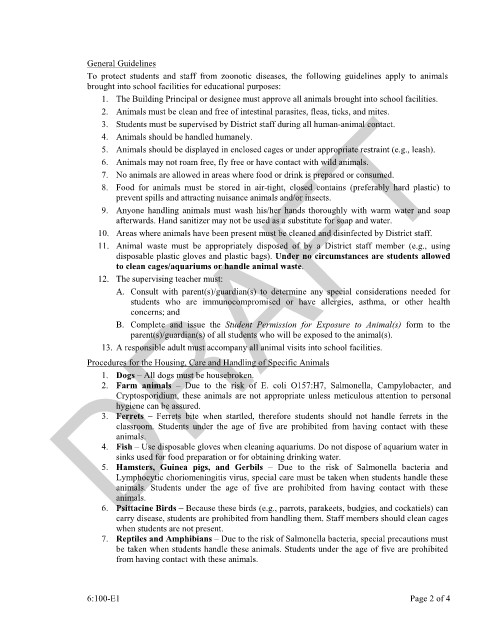Page 988 - draft
P. 988
General Guidelines
To protect students and staff from zoonotic diseases, the following guidelines apply to animals
brought into school facilities for educational purposes:
1. The Building Principal or designee must approve all animals brought into school facilities.
DRAFT
2. Animals must be clean and free of intestinal parasites, fleas, ticks, and mites.
3. Students must be supervised by District staff during all human-animal contact.
4. Animals should be handled humanely.
5. Animals should be displayed in enclosed cages or under appropriate restraint (e.g., leash).
6. Animals may not roam free, fly free or have contact with wild animals.
7. No animals are allowed in areas where food or drink is prepared or consumed.
8. Food for animals must be stored in air-tight, closed contains (preferably hard plastic) to
prevent spills and attracting nuisance animals and/or insects.
9. Anyone handling animals must wash his/her hands thoroughly with warm water and soap
afterwards. Hand sanitizer may not be used as a substitute for soap and water.
10. Areas where animals have been present must be cleaned and disinfected by District staff.
11. Animal waste must be appropriately disposed of by a District staff member (e.g., using
disposable plastic gloves and plastic bags). Under no circumstances are students allowed
to clean cages/aquariums or handle animal waste.
12. The supervising teacher must:
A. Consult with parent(s)/guardian(s) to determine any special considerations needed for
students who are immunocompromised or have allergies, asthma, or other health
concerns; and
B. Complete and issue the Student Permission for Exposure to Animal(s) form to the
parent(s)/guardian(s) of all students who will be exposed to the animal(s).
13. A responsible adult must accompany all animal visits into school facilities.
Procedures for the Housing, Care and Handling of Specific Animals
1. Dogs – All dogs must be housebroken.
2. Farm animals – Due to the risk of E. coli O157:H7, Salmonella, Campylobacter, and
Cryptosporidium, these animals are not appropriate unless meticulous attention to personal
hygiene can be assured.
3. Ferrets – Ferrets bite when startled, therefore students should not handle ferrets in the
classroom. Students under the age of five are prohibited from having contact with these
animals.
4. Fish – Use disposable gloves when cleaning aquariums. Do not dispose of aquarium water in
sinks used for food preparation or for obtaining drinking water.
5. Hamsters, Guinea pigs, and Gerbils – Due to the risk of Salmonella bacteria and
Lymphocytic choriomeningitis virus, special care must be taken when students handle these
animals. Students under the age of five are prohibited from having contact with these
animals.
6. Psittacine Birds – Because these birds (e.g., parrots, parakeets, budgies, and cockatiels) can
carry disease, students are prohibited from handling them. Staff members should clean cages
when students are not present.
7. Reptiles and Amphibians – Due to the risk of Salmonella bacteria, special precautions must
be taken when students handle these animals. Students under the age of five are prohibited
from having contact with these animals.
6:100-E1 Page 2 of 4

